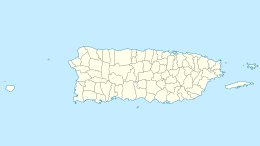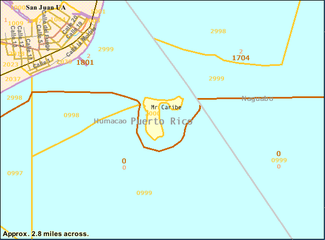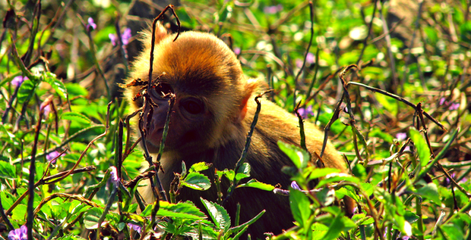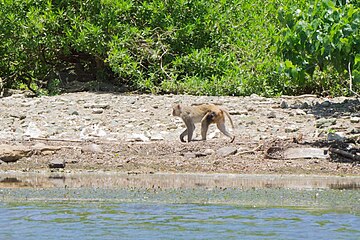geo.wikisort.org - Island
Cayo Santiago, also known as Santiago Island, Isla de los monos (or Island of the monkeys), is located at 18°09′23″N 65°44′03″W, 0.59 mi (0.95 km) 0.6 mi (1.0 km) to the east of Punta Santiago, Humacao, Puerto Rico.[1][2]
 | |
 Cayo Santiago  Cayo Santiago  Cayo Santiago | |
| Geography | |
|---|---|
| Location | Humacao, Puerto Rico |
| Coordinates | 18°9′23″N 65°44′3″W |
| Area | 0.139179 km2 (0.053737 sq mi) |
| Length | 0.6 km (0.37 mi) |
| Width | 0.4 km (0.25 mi) |
| Highest elevation | 34.9 m (114.5 ft) |
| Highest point | El Morrillo or "Big Cay hill top" |
| Administration | |
| Commonwealth | Puerto Rico |
| Municipality | Humacao |
Geography
The island measures approximately 37.5 acres (15.2 ha), 660 yards (600 m) north–south and 440 yards (400 m) east–west, including a "Small Key" which is connected to the main part ("Big Key") by a narrow sandy isthmus. Six hundred meters west of the southernmost point is a shoal, Bajo Evelyn, which has a shallow depth of 8 fathoms. While the island is flat in the north, it reaches a height of 114.5 ft (34.9 m), 1.8 mi (2.9 km) southwest of the island's port, on a small rocky hill called El Morrillo, which rises abruptly from the water and the lowland around it. The area of the island is 0.054 sq mi (0.14 km2): Block 2000, Census Block Group 2, Census tract 1801, Humacao Municipio, Puerto Rico), of which the northeastern peninsula accounts for about 0.01 sq mi (0.03 km2).[3]
In the late 1940s, the island was expropriated by Puerto Rico from its private owners and ceded to the University of Puerto Rico. Only researchers are allowed on the island, but tourists can charter a boat to view the island and its primate inhabitants.[4]
Resident Taxa
Since December 1938, the island has been home to a free-ranging population of rhesus macaques. Today, the island is inhabited by descendants of the original founder population of 409 individuals.[5] Founder individuals were imported from India by Clarence R. Carpenter[1] and the School of Tropical Medicine in San Juan that was operated by Columbia University College of Physicians and Surgeons and the University of Puerto Rico. Today, the colony, which numbers over one thousand animals, serves as a research resource supported by the National Institutes of Health and the University of Puerto Rico Caribbean Primate Research Center for investigators from many institutions in the US and several in Europe. A pictorial history on the 75 years of the colony was recently published.[1]
Cayo Batata, a small island located 4 mi (6 km) to the southwest of Cayo Santiago, is under the jurisdiction of Humacao and is uninhabited by humans.
Gallery
 Nautical Chart of Cayo Santiago area
Nautical Chart of Cayo Santiago area Census Bureau Map
Census Bureau Map
 Shy monkey at Cayo Santiago, Puerto Rico
Shy monkey at Cayo Santiago, Puerto Rico- A monkey walks on the beach of Cayo Santiago
References
- Kessler, Matthew J.; Rawlins, Richard G. (2016). "A 75‐year pictorial history of the Cayo Santiago rhesus monkey colony". American Journal of Primatology. 78 (1): 6–43. doi:10.1002/ajp.22381. ISSN 1098-2345. PMC 4567979. PMID 25764995.
- Congress, The Library of. "LC Linked Data Service: Authorities and Vocabularies (Library of Congress)". id.loc.gov. Retrieved 2021-03-26.
- "Puerto Rico and Virgin Islands NOAA Chart 25640" (PDF). NOAA. NOAA. Retrieved 29 October 2020.
- "Monkey Island". Atlas Obscura. Retrieved 15 June 2019.
- The Cayo Santiago macaques : history, behavior, and biology. Richard G. Rawlins, Matt J. Kessler. Albany: State University of New York Press. 1986. ISBN 0-585-07492-5. OCLC 42855829.
{{cite book}}: CS1 maint: others (link)
External links
- Cayo Santiago & The Origins NIH NPRC Program with Hurricane Maria of 9/20/2017 update
- Video about the monkeys on Cayo Santiago
- Caribbean Primate Research Center
- University of Puerto Rico page
- Primate Research Center
На других языках
[de] Cayo Santiago
Cayo Santiago, auch bekannt als Monkey Island, ist eine unbewohnte Insel im Karibischen Meer, die sich 950 m südöstlich von Punta Santiago, Humacao, Puerto Rico befindet. Sie erstreckt sich über 600 Meter von Norden nach Süden und 400 Meter von Osten nach Westen einschließlich der flachen nordöstlich gelegenen Halbinsel, die mit der Hauptinsel nur durch einen engen sandigen Isthmus verbunden ist.- [en] Cayo Santiago
Другой контент может иметь иную лицензию. Перед использованием материалов сайта WikiSort.org внимательно изучите правила лицензирования конкретных элементов наполнения сайта.
WikiSort.org - проект по пересортировке и дополнению контента Википедии



